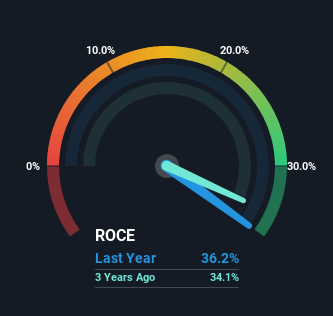- Singapore
- /
- Professional Services
- /
- SGX:TCU
Credit Bureau Asia (SGX:TCU) Is Reinvesting At Lower Rates Of Return

Did you know there are some financial metrics that can provide clues of a potential multi-bagger? Ideally, a business will show two trends; firstly a growing return on capital employed (ROCE) and secondly, an increasing amount of capital employed. Ultimately, this demonstrates that it's a business that is reinvesting profits at increasing rates of return. Having said that, while the ROCE is currently high for Credit Bureau Asia (SGX:TCU), we aren't jumping out of our chairs because returns are decreasing.
Understanding Return On Capital Employed (ROCE)
If you haven't worked with ROCE before, it measures the 'return' (pre-tax profit) a company generates from capital employed in its business. The formula for this calculation on Credit Bureau Asia is:
Return on Capital Employed = Earnings Before Interest and Tax (EBIT) ÷ (Total Assets - Current Liabilities)
0.36 = S$27m ÷ (S$97m - S$24m) (Based on the trailing twelve months to June 2024).
Therefore, Credit Bureau Asia has an ROCE of 36%. In absolute terms that's a great return and it's even better than the Professional Services industry average of 23%.
Check out our latest analysis for Credit Bureau Asia

Above you can see how the current ROCE for Credit Bureau Asia compares to its prior returns on capital, but there's only so much you can tell from the past. If you're interested, you can view the analysts predictions in our free analyst report for Credit Bureau Asia .
What Can We Tell From Credit Bureau Asia's ROCE Trend?
On the surface, the trend of ROCE at Credit Bureau Asia doesn't inspire confidence. While it's comforting that the ROCE is high, five years ago it was 50%. However, given capital employed and revenue have both increased it appears that the business is currently pursuing growth, at the consequence of short term returns. If these investments prove successful, this can bode very well for long term stock performance.
On a related note, Credit Bureau Asia has decreased its current liabilities to 25% of total assets. So we could link some of this to the decrease in ROCE. What's more, this can reduce some aspects of risk to the business because now the company's suppliers or short-term creditors are funding less of its operations. Since the business is basically funding more of its operations with it's own money, you could argue this has made the business less efficient at generating ROCE.
The Key Takeaway
In summary, despite lower returns in the short term, we're encouraged to see that Credit Bureau Asia is reinvesting for growth and has higher sales as a result. These growth trends haven't led to growth returns though, since the stock has fallen 13% over the last three years. So we think it'd be worthwhile to look further into this stock given the trends look encouraging.
If you'd like to know about the risks facing Credit Bureau Asia, we've discovered 1 warning sign that you should be aware of.
If you'd like to see other companies earning high returns, check out our free list of companies earning high returns with solid balance sheets here.
New: AI Stock Screener & Alerts
Our new AI Stock Screener scans the market every day to uncover opportunities.
• Dividend Powerhouses (3%+ Yield)
• Undervalued Small Caps with Insider Buying
• High growth Tech and AI Companies
Or build your own from over 50 metrics.
Have feedback on this article? Concerned about the content? Get in touch with us directly. Alternatively, email editorial-team (at) simplywallst.com.
This article by Simply Wall St is general in nature. We provide commentary based on historical data and analyst forecasts only using an unbiased methodology and our articles are not intended to be financial advice. It does not constitute a recommendation to buy or sell any stock, and does not take account of your objectives, or your financial situation. We aim to bring you long-term focused analysis driven by fundamental data. Note that our analysis may not factor in the latest price-sensitive company announcements or qualitative material. Simply Wall St has no position in any stocks mentioned.
About SGX:TCU
Credit Bureau Asia
An investment holding company, provides credit and risk information solutions in Singapore, Malaysia, Cambodia, and Myanmar.
Outstanding track record with flawless balance sheet.
Market Insights
Community Narratives



